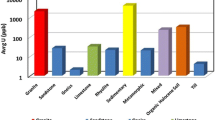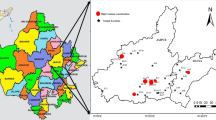Abstract
This paper presents the isotope hydrochemical results of groundwaters from southwest Punjab for assessing the uranium contamination and evaluating the factors leading to elevated uranium concentration. A total of 35 samples covering shallow and deep zones were collected for hydrochemistry and isotopes. Uranium concentration ranges between 2.3 and 357 µg L−1 and 66% of the samples are contaminated. Both shallow and deep zones show U contamination but high incidences are noticed in shallow zone. Hydrochemical correlations infer geological sources rather than anthropogenic sources responsible for U contamination. Isotopically there is no clear distinction between high and low U groundwater.






Similar content being viewed by others
References
Bhattacharya P, Ramanathan AL, Mukherjee AB, Bundschuh J, Chandrasekharam D, Keshari AK (2008) Groundwater for sustainable development: problems, perspectives and challenges. CRC Press, Boca Raton
Sharma DA, Rishi MS, Keesari T (2016) Evaluation of groundwater quality and suitability for irrigation and drinking purposes in Southwest Punjab, India using hydrochemical Approach. Appl Water Sci. doi:10.1007/s13201-016-0456-6
Sharma DA, Rishi MS, Keesari T (2016) Understanding the factors responsible for groundwater contamination in parts of southwest Punjab, India. J Energy Environ Carbon Credits 6:7–23
Sharma DA, Rishi MS, Keesari T, Sinha UK (2016) Assessment of groundwater quality of Bathinda district, Punjab with reference to nitrate contamination. J Appl Geochem 18(4):480–489
Thakur T, Rishi MS, Naik PK, Sharma P (2016) Elucidating hydrochemical properties of groundwater for drinking and agriculture in parts of Punjab, India. Environ Earth Sci 75:467–471
Kumar A, Usha N, Sawant PD, Tripathi RM, Raj SS, Mishra M, Rout S, Supreeta P, Singh J, Kumar S, Kushwaha HS (2011) Risk assessment for natural uranium in subsurface water of Punjab state, India. Hum Ecol Risk Assess 17:381–393
Keesari T, Chawla D, Sinha UK, Kumar A, Rishi M (2015) In: Kannan S, Kannan S, Mukerjee SK, Ramakumar KL (eds) Occurrence of uranium in parts of southwest Punjab its interrelation with physicochemical parameters. Board of Research in Nuclear Sciences, India
Singh J, Singh L, Singh G (1995) High U-contents observed in some drinking waters of Punjab, India. J Environ Radioact 26:217–222
Sharma N, Singh J (2016) Radiological and chemical risk assessment due to high uranium contents observed in the ground waters of Mansa District (Malwa region) of Punjab state, India: an area of high cancer incidence. Expo Health. doi:10.1007/s12403-016-0215-9
ATSDR (2011) Toxicological profile for uranium: agency for toxic substances and disease registry. U.S. Department of Health and Human Services. Public Health Service, Atlanta
Kurttio P, Auvinen A, Salonen L, Saha H, Pekkanen J, Makelainen I, Vaisanen SB, Penttila IM, Komulainen H (2002) Renal effects of uranium in drinking water. Environ Health Perspect 110(4):337–342
ATSDR (2013) Toxicological profile for uranium. U.S. Department of Health and Human Services. Public Health Service. Agency for toxic substances and disease registry. Atlanta https://www.atsdr.cdc.gov/toxprofiles/tp150.pdf
WHO (2012) Uranium in drinking-water. Background document for preparation of WHO guidelines for drinking-water quality. Geneva, World Health Organization (WHO/SDE/WSH/03.04/118/Rev/1)
AERB, DAE (2004) Drinking water specifications in India. Atomic Energy Regulatory Board, Mumbai
Guthrie VA, Kleeman JD (1986) Changing uranium distributions during weathering of granite. Chem Geol 54:113–126
Hess CT, Michel J, Horton TR, Prichard HM, Conigilio WA (1985) The occurrence of radioactivity in public water supplies in the United States. Health Phys 48:553–586
Langmuir D (1997) Aqueous environmental geochemistry, vol 7th ed. Prentice Hall, New York
Clark ID, Fritz P (1997) Environmental isotopes in hydrogeology. Lewis Publishers, New York
Fontes CH (1981) Environmental isotopes in groundwater hydrology, In: Fritz P and Fontes JCH (eds.) Handbook of environmental isotopes geochemistry, The terrestrial environment A, Vol 1. Elsevier Scientific Publishing Co, Amsterdam, 1980, pp 75–140
Herczeg A, Lamontagne S, Pritchard J, Leaney F, Dighton J (1992) Groundwater-surface water interactions: testing conceptual models with environmental tracers. 8th Murray Darling Basin groundwater workshop, Victor Harbor, South Australia.6B.3
Gat JR (1981) Stable isotope hydrology: deuterium and oxygen-18 in the water cycle In: Gat JR and Gonfiantini R (eds.), IAEA technical reports series, No. 210. IAEA (International Atomic Energy Agency), Vienna
Shivanna K, Tirumalesh K, Noble J, Joseph TB, Singh G, Joshi AP, Khati VS (2008) Isotope techniques to identify recharge areas of springs for rainwater harvesting in the mountainous region of Gaucher area, Chamoli District, Uttarakhand. Curr Sci 94(8):1003–1011
Rao SM, Kulkarni KM (1997) Isotope hydrology studies on water resources in western Rajasthan. Curr Sci 72:55–61
Keesari T, Shivanna K, Jalihal AA (2007) Isotope hydrochemical approach to understand Fluoride release into groundwaters of Ilkal Area, Bagalkot District, Karnataka, India. Hydrogeol J 15:589–598
Keesari T, Mohokar HV, Sahoo BK, Mallesh G (2014) Assessment of environmental radioactive elements in groundwater in parts of Nalgonda district, Andhra Pradesh, South India using scintillation detection methods. J Radioanal Nucl Chem 302:1391–1398
Keesari T, Shivanna K, Noble J, Narayan KK, Xavier KT (2007) Nuclear techniques to investigate source and origin of groundwater pollutants and their flow path at Indian Rare Earths Ltd, Cochin, Kerala. J Radioanal Nucl Chem 274:307–313
Kochhar N, Dadwal V, Rishi M, Sharma NK, Balaram V (2012) Evaluation of chemical quality of groundwater in parts of Sirsa (Harayana), Mansa, Bhatinda and Muktsar Districts, SW Punjab with emphasis on uranium in relation to human health. In: Proceedings of 5th IGWC-2012 on the assessment and management of groundwater resources in hard rock systems with special reference to basaltic terrain, 611–626
Patnaik R, Lahiri S, Chahar V, Naskar N, Sharma PK, Avhad DK, Bassan MKT, Knolle F, Schnug E, Srivastava A (2016) Study of uranium mobilization from Himalayan Siwaliks to the Malwa region of Punjab state in India. J Radioanal Nucl Chem 308(3):913–918
Phadke AV, Mahadevan TM, Narayandas GR, Saraswat AC (1985) Uranium mineralisation in some phanerozoic sandstones of India, In: Geological environments of sandstone-type uranium deposits. IAEA-TECDOC-328,121–134
Singh L, Kumar R, Kumar S, Bajwa BS, Singh S (2013) Health risk assessments due to uranium contamination of drinking water in Bathinda region, Punjab state,India. Radioprotection 48(02):191–202
Bajwa BS, Kumar S, Singh S, Sahoo SK, Tripathi RM (2015) Uranium and other heavy toxic elements distribution in the drinking water samples of SW-Punjab, India. J Radiat Res Appl Sci 10(1):13–19
Rishi MS, Keesari T, Sharma DA, Pant D, Uday Sinha K (2017) Spatial trends in uranium distribution in groundwaters of Southwest Punjab, India-a hydrochemical perspective. J Radioanal Nucl Chem 311(3):1937–1945
Krishan G, Rao MS, Kumar CP, Semwal P (2013) Identifying salinization using isotopes and ion chemistry in semi-arid region of Punjab, India. J Geol Geosci 2:4. doi:10.4172/jgg.1000129
CGWB (2013) Groundwater information booklet. Bathinda District, Punjab A report. http://cgwb.gov.in/District_Profile/Punjab/Bathinda.pdf
CGWB (2013) Groundwater information booklet. Mansa District, Punjab A report. http://www.cgwb.gov.in/District_Profile/Punjab/Mansa.pdf
Gupta S, Thakur RS (1989) Report on hydrogeology of District Bathinda, Punjab State (F.S.P. 1989–93). Central Ground Water Board, North Western Region, Chandigarh
Sharma M, Sharma YC, Basu B, Chhabra J, Gupta RK, Singh J (2000) Uranium mineralization in the sandstones of Dharamsala, Tileli area, Mandi district, Himachal Pradesh, India. CurrSci 78:897–899
Tripathi A, Mishra AK, Verma G (2016) Impact of preservation of subsoil water act on groundwater depletion: the case of Punjab, India. Environ Manag 58(1):48–59
Dhiman SC (2012) Aquifer systems of India. Central Ground Water Board, Ministry of Water Resources, Government of India, Guwahati, p 111
Hounslow AW (1995) Water quality data—analysis and interpretation. Lewis Publishers, CRC Press, Florida
Plummer LN, Jones BF, Truesdell AH (1976) WATEQF—A Fortran IV Version Of WATEQ, A computer program for calculating chemical equilibrium of natural waters. US Geol Surv Water Resources Investigations Report, 76–13
Ohsumi T, Fujino H (1986) Isotopic exchange technique for preparation of hydrogen gas in mass spectrometric D/H analysis of natural waters. Anal Sci 2:489–490
Epstein S, Mayeda T (1953) Variation of 18O contents of water from natural sources. Geochim Cosmochim Acta 4:213–224
Horita J, Ueda A, Mizukami K, Takatori I (1989) Automatic δD and δ18O analyses of multi-water samples using H2- and CO2-water equilibration methods with a common equilibration set-up. Int J Radiat Appl Instrum 40:801–805
Coplen TB (1996) New guidelines for reporting stable hydrogen, carbon and oxygen isotope-ratio data. Geochim Cosmochim Acta 60:3359–3360
Sahoo SK, Mohapatra S, Chakrabarty A, Sumesh CG, Jha VN, Tripathi RM, Puranik VD (2010) Determination of uranium at ultra trace level in packaged drinking water by laser fluorimeter and consequent ingestion dose. Radioprotection 45:55–66. doi:10.1051/radiopro/2009030
Kass A, Gavrieli I, Yechieli Y, Vengosh A, Starinsky A (2005) The impact of freshwater and wastewater irrigation on the chemistry of shallow groundwater: a case study from the Israeli Coastal Aquifer. J Hydrol 300(1):314–331
Nolan BT, Hitt KJ (2006) Vulnerability of shallow groundwater and drinking-water wells to nitrate in the United States. Environ SciTechnol 40(24):7834–7840
Thivya C, Chidambaram S, Keesari T, Prasanna MV, Thilagavathi R, Adithya VS, Singaraja C (2016) Lithological and hydrochemical controls on distribution and speciation of uranium in groundwaters of hard-rock granitic aquifers of Madurai District, Tamil Nadu (India). Environ Geochem Health 38(2):497–509
Thivya C, Chidambaram S, Tirumalesh K, Prasanna MV, Thilagavathi R, Nepolian M (2014) Occurrence of the radionuclides in groundwater of crystalline hard rock regions of central Tamil Nadu, India. J Radioanal Nucl Chem 302:1349–1355. doi:10.1007/s10967-014-3630-z
Nolan J, Weber KA (2015) Natural uranium contamination in major US aquifers linked to nitrate. Environ Sci Technol Lett 2(8):215–220
Craig H (1961) Isotopic variations in meteoric waters. Science 133:1702–1703
Acknowledgements
Authors sincerely acknowledge the constant support and encouragement by Shri K. S. S. Sarma, Head, Isotope and Radiation Application Division and Dr. B. S. Tomar, Director, Radiochemistry and Isotope Group, Bhabha Atomic Research Centre, Mumbai. The authors would like to acknowledge the BRNS, DAE for providing the financial support (letter no. 35/14/11/2014-BRNS-193).
Author information
Authors and Affiliations
Corresponding author
Rights and permissions
About this article
Cite this article
Sharma, D.A., Rishi, M.S., Keesari, T. et al. Distribution of uranium in groundwaters of Bathinda and Mansa districts of Punjab, India: inferences from an isotope hydrochemical study. J Radioanal Nucl Chem 313, 625–633 (2017). https://doi.org/10.1007/s10967-017-5288-9
Received:
Published:
Issue Date:
DOI: https://doi.org/10.1007/s10967-017-5288-9




